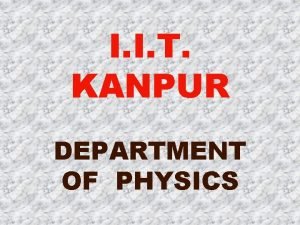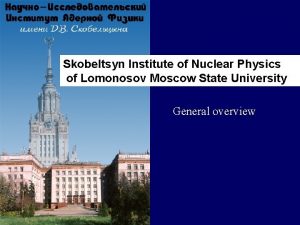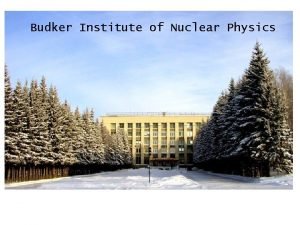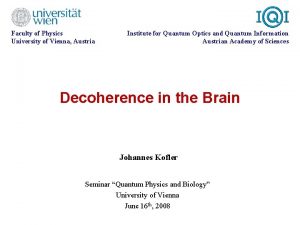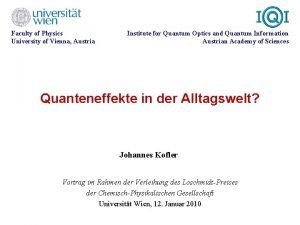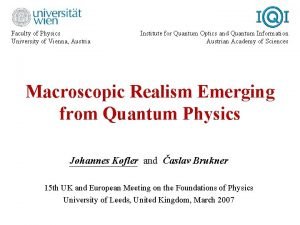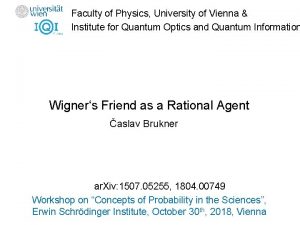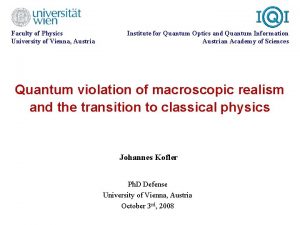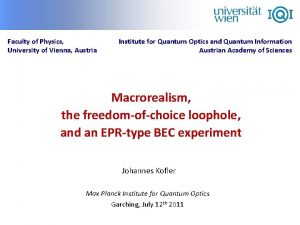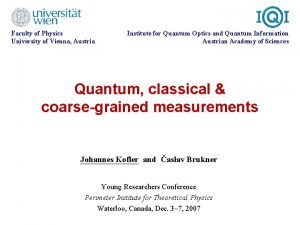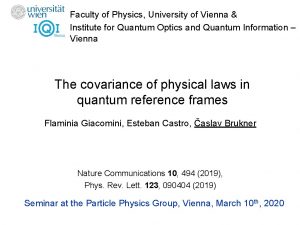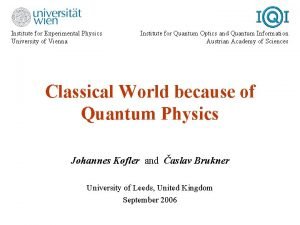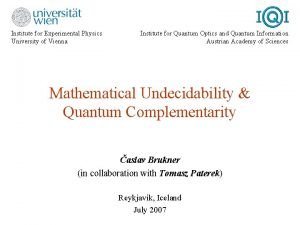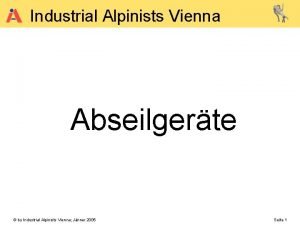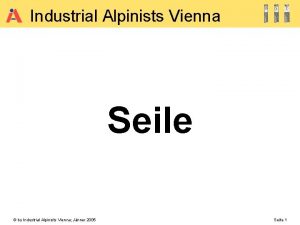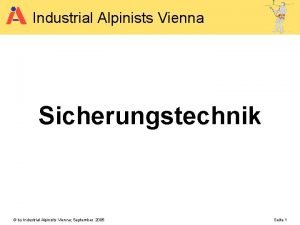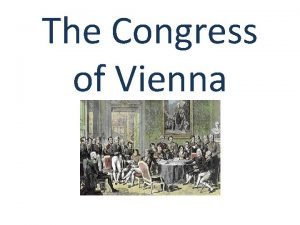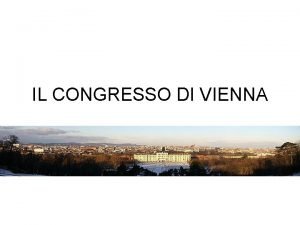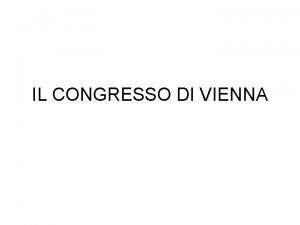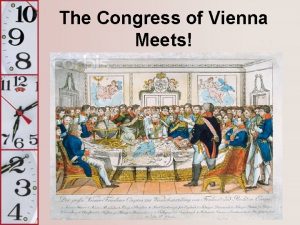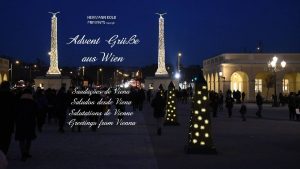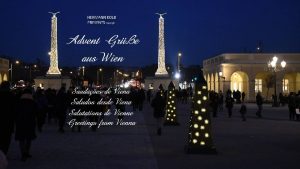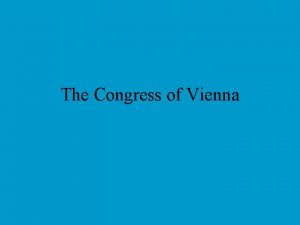Faculty of Physics University of Vienna Institute for







































- Slides: 39

Faculty of Physics, University of Vienna & Institute for Quantum Optics and Quantum Information, Vienna Indefinite causal order in quantum mechanics Časlav Brukner Mateus Araujo, Cyril Branciard, Fabio Costa, Adrian Feix, Christina Giarmatzi, Ognyan Oreshkov, Magdalena Zych The 11 th “Vienna Central European Seminar on Particle Physics and Quantum Field Theory”

Possible causal influences

Question: Can one have situations in which the causal order is not fixed, but rather is subject to quantum indefiniteness?

Question: Can one have situations in which the causal order is not fixed, but rather is subject to quantum indefiniteness? Dynamical causal structure of general relativity + Superposition principle of quantum mechanics

Question: Can one have situations in which the causal order is not fixed, but rather is subject to quantum indefiniteness? Dynamical causal structure of general relativity + Superposition principle of quantum mechanics

Question: Can one have situations in which the causal order is not fixed, but rather is subject to quantum indefiniteness? Dynamical causal structure of general relativity + Superposition principle of quantum mechanics

Outline § “Causal inequalities“ Device-independent approach to causality § Framework for quantum mechanics with no assumed global causal structure: Device-dependent approach to causality Causally non-separable processes § Quantum computation with indefinite order of gates Computational task that cannot be accomplished on a computer with fixed order of gates § Physical realization of causally non-separable processes Linear optical schemes & via superposition of large masses

“Correlation does not imply causation”

The notion of “causation” Effect Cause One-directional signalling Necessity of interventions, or free variables, statistically independent of “the rest of the experiment”

The notion of “causation” One-directional signalling Necessity of interventions, or free variables, statistically independent of “the rest of the experiment”

Definite causal order No-signalling Space-like separated One-directional signalling Alice before Bob Time-like separated

Causal inequalities (Device-independent approach to causality) Assumptions: § System enters each laboratory only once. § The laboratories are shielded and interact with “the outside world” only through the system entering and exiting it. Causal correlations: either A signals to B or B signals to A, or no-signalling or a convex combination of these situations.

Causal inequalities (Device-independent approach to causality) No-signalling One-directional signalling: Alice to Bob Causal correlations: either A signals to B or B signals to A, or no-signalling or a convex combination of these situations.

The simplest causal inequality 1 bit input, 1 bit output Causal correlations satisfy causal inequalities, which are facets of the causal polytope Guess Your Neighbour’s Input (GYNI) game: C. Branciard, M. Araújo, A. Feix, F. Costa, Č. B. , to appear in New J. Phys. (2015)

“Non-causal correlations” (violating causal inequalities) Interpretation: Both A signals to B and B signals to A, although the system enters only once the laboratory and the laboratories are shielded. Two-directional signalling

Local quantum laboratory (Device-dependent approach to causality) Output space Future Hilbert space-like surface Input Past space-like Hilbert space surface

Local quantum laboratory (Device-dependent approach to causality) Output space Future Hilbert space-like surface Input Past space-like Hilbert space surface Transformations = completely positive (CP) trace-nonincreasing maps

Many local quantum laboratories b c Quantum mechanics locally valid. (no globar causal order fixed) Probabilities: Process matrix: O. Oreshkov, F. Costa, Č. B. , Nature Communication 3: 1092 (2012)

Conditions on W b c Quantum mechanics locally valid. (no global causal order fixed) Positivity: Normalization: O. Oreshkov, F. Costa, Č. B. , Nature Communication 3: 1092 (2012)

Forbidden processes No “grandfather paradox” Single Loops Double Loops O. Oreshkov, F. Costa, Č. B. , Nature Communication 3: 1092 (2012)

Admissible processes Channels from Alice to Bob Time-like separated States Space-like separated O. Oreshkov, F. Costa, Č. B. , Nature Communication 3: 1092 (2012)

Causally separable processes Ordered processes: A signals to B, or no signaling B signals to A, or no signaling Most general processes compatible with definite causal structure (convex mixtures of ordered processes): There are causally non-separable processes

Quantum switch – quantum control of causal order Path degree of freedom (quantum control) Internal degree of freedom Alice Bob Channel from Alice to Bob Channel from Bob to Alice

Quantum switch – quantum control of causal order Bob Cleve Alice Quantum switch is a causally nonseparable process

Quantum switch – quantum control of causal order Bob Cleve Alice Quantum switch is a causally nonseparable process However, the switch cannot violate a „causal inequality“

„Superposition of unitarities“ Bob Alice Cleve

Computational advantages 1 C. Branciard, M. Araújo, A. Feix, F. Costa, and C. B. , ar. Xiv: 1508. 01704 (2015). Colnaghi, G. M. D’Ariano, S. Facchini, and P. Perinotti, Phys. Lett. A 376, 29402943 (2012) 3 G. Chiribella, Phys. Rev. A 86, 040301(R) (2012) 4 M. Araujo, F. Costa, and C. B. , Phys. Rev. Lett. 113, 250402 (2015) 5 A. Feix, M. Araujo, and C. B. Phys. Rev. A 92, 052326 (2015)

Experimental Demonstration L. M. Procopio et. al, Nature Communication 6, 7913

Order of events determined by their position in space-time B A

General relativity: space-time is dynamical

General relativity: space-time is dynamical Proper times of clocks a & b Dynamics of the clock describe M. Zych, F. Costa, I. Pikovski, Č. B. , Nature Communication 2: 505 (2011) I. Pikovski, M. Zych, F. Costa, Č. B. , Nature Physics 11, 668 (2015)

General relativity: space-time is dynamical Proper times of clocks a & b Dynamics of the clock describe M. Zych, F. Costa, I. Pikovski, Č. B. , Nature Communication 2: 505 (2011) I. Pikovski, M. Zych, F. Costa, Č. B. , Nature Physics 11, 668 (2015)

Gravitational quantum switch Quantum control of temporal order

Summary and Outlook § Global causal order need not be a necessary element of quantum theory. § There exist physical processes that are causally nonseparable. § Causally nonseparable processes is a new resource for quantum information processing § The framework also includes processes with no (known) physical interpretation § Does a theory of quantum gravity provide a physical interpretation to such processes?

Thank you! quantumfoundations. org

Force-free time dilation Potential R r A r. B B r

Relative degrees of freedom = Local clock Superposition of backgrouds Clock in a superposition Fixed backgroud

Clock in a superposition running clock in a superposition GR: time shown by the clock depends on the path taken QM: either path or interference QM+GR: interference cannot be observed since the whichpath information is stored in the clock time

Visibility modulation Difference in proper time Orthogonalization time M. Zych, F. Costa, I. Pikovski, Č. B. , Nature Communication 2: 505 (2011) I. Pikovski, M. Zych, F. Costa, Č. B. , Nature Physics 11, 668 (2015)
 University physics with modern physics fifteenth edition
University physics with modern physics fifteenth edition Iit kanpur physics department
Iit kanpur physics department Herszon kherson maritime college of merchant marine fleet
Herszon kherson maritime college of merchant marine fleet Bridgeport engineering department
Bridgeport engineering department University of bridgeport computer science
University of bridgeport computer science Hubert kairuki memorial university faculty of medicine
Hubert kairuki memorial university faculty of medicine Solid thyroid nodule
Solid thyroid nodule Applied medical sciences
Applied medical sciences Florida state computer science
Florida state computer science Faculty of business and economics mendel university in brno
Faculty of business and economics mendel university in brno Singularity executive program
Singularity executive program Semmelweis university faculty of medicine
Semmelweis university faculty of medicine Masaryk university medical faculty
Masaryk university medical faculty Faculty of engineering university of porto
Faculty of engineering university of porto Webkredit cuni
Webkredit cuni Faculty of veterinary medicine cairo university logo
Faculty of veterinary medicine cairo university logo Faculty of law of the university of zagreb
Faculty of law of the university of zagreb University of montenegro faculty of law
University of montenegro faculty of law University of kragujevac faculty of technical sciences
University of kragujevac faculty of technical sciences University of cologne faculty of management
University of cologne faculty of management Leading university teacher
Leading university teacher Hacettepe university faculty of medicine
Hacettepe university faculty of medicine Brown university computer science faculty
Brown university computer science faculty Auricle of heart vs atrium
Auricle of heart vs atrium Semmelweis university faculty of medicine
Semmelweis university faculty of medicine Roumieh university
Roumieh university Myfile york university
Myfile york university Faculty of economics and business debrecen
Faculty of economics and business debrecen Clemson electrical engineering
Clemson electrical engineering Faculty of veterinary medicine cairo university
Faculty of veterinary medicine cairo university Faculty of mechanical engineering thammasat university
Faculty of mechanical engineering thammasat university Mendel university faculty of business and economics
Mendel university faculty of business and economics Chronic meningitis
Chronic meningitis Slidetodoc.com
Slidetodoc.com Thick and thin malaria smear
Thick and thin malaria smear Faculty of education khon kaen university
Faculty of education khon kaen university Shawhong ser
Shawhong ser Cairo university faculty of veterinary medicine
Cairo university faculty of veterinary medicine Skobeltsyn institute of nuclear physics
Skobeltsyn institute of nuclear physics Budker institute of nuclear physics
Budker institute of nuclear physics

